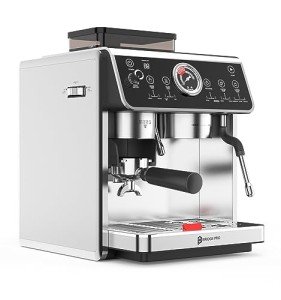The Ultimate Guide to Cappuccino Machines: Brewing the Perfect Cup
Cappuccinos are a cherished coffee drink that combines the abundant tastes of espresso with steamed milk and milk foam. For many, nothing tastes better than a homemade cappuccino crafted with precision. Nevertheless, reproducing the ability of a barista at home requires the ideal devices. Espresso Machines Under £100 is where cappuccino machines come into play. This post digs into the numerous types of cappuccino machines, how they work, and suggestions for selecting the best one for your needs.
What is a Cappuccino Machine?
A cappuccino machine is a specific brewing device developed to make coffees and other espresso-based drinks. Espresso Machines With Milk Frother feature a built-in espresso maker, a milk frother, and different controls for adjusting temperature level and pressure. Cappuccino machines can be manual, semi-automatic, or completely automatic, offering different levels of user control depending upon the complexity of the machine.
Types of Cappuccino Machines
1. Manual Espresso Machines
- Description: These machines need users to run most functions manually, consisting of grinding coffee beans, tamping the premises, pulling the espresso shot, and frothing the milk.
- Pros:
- Offers complete control over the brewing procedure.
- Can produce high-quality, café-like espresso.
- Cons:
- Steeper learning curve.
- Requires more effort and time.
2. Semi-Automatic Espresso Machines
- Description: Semi-automatic machines automate some processes, such as water pressure. Users still require to grind coffee and froth milk manually.
- Pros:
- Balanced control and convenience.
- Allows space for experimentation.
- Cons:
- Still requires useful skills.
- Can be complicated for beginners.
3. Totally Automatic Espresso Machines
- Description: These machines automate the whole developing process, from grinding to frothing. Users just pick the wanted drink.
- Pros:
- Extremely convenient and easy to use.
- Constant results with little effort.
- Cons:
- More costly.
- Limited control over the developing process.
4. Super Automatic Espresso Machines
- Description: Similar to totally automatic machines, but these designs include functions like an integrated milk frother and grinder. They prepare beverages with simply the touch of a button.
- Pros:
- Ultimate convenience; makes numerous beverages rapidly.
- Built-in cleansing and upkeep features.
- Cons:
- High initial expense.
- Less hands-on experience with coffee making.
Secret Features to Consider
When picking a cappuccino machine, numerous features can significantly affect performance and user experience. Here are some important aspects to evaluate:
1. Develop Quality
- Materials used (stainless steel, plastic)
- Durability and longevity
2. Capability
- Water tank size
- Bean hopper capacity
3. Frothing Capability
- Kind of frothing wand (manual, automatic)
- Steam pressure and temperature control
4. Reduce of Use
- Intuitive controls
- Cleaning and upkeep requirements
5. Rate
- Range from budget to high-end models
- Think about guarantees and consumer assistance choices
6. Brand name Reputation
- User reviews and expert viewpoints
- Accessibility of replacement parts
The Brewing Process
To brew the perfect cappuccino in the house, follow this procedure, regardless of the machine type:
- Prepare the Espresso: Use newly ground coffee beans and pull a double shot (approximately 2 ounces) of espresso.
- Froth the Milk: Steam fresh milk to a temperature about 150 ° F( 65 ° C)using the steam wand or automatic frother.
- Combine: Pour the steamed milk over the espresso, followed by a layer of milk foam (equal parts espresso and steamed milk, with about 1 cm of foam).
For a visual representation, here's a simple table comparing the attributes of the cappuccino machine types:
| Machine Type | Control Level | Ease of Use | Rate Range | Suitable For |
|---|---|---|---|---|
| Manual Espresso Machine | High | Challenging | Low to Medium | Coffee lovers, perfectionists |
| Semi-Automatic Machine | Medium | Moderate | Medium | Home baristas, hobbyists |
| Completely Automatic Machine | Low | Easy | Medium to High | Casual drinkers |
| Super Automatic Machine | Really Low | Very Easy | High | Busy experts |
Regularly Asked Questions (FAQs)
What is the very best milk to use for cappuccinos?
Entire milk is commonly chosen for frothing due to its fat content, which produces a creamy texture. However, options like almond milk, oat milk, or soy milk can be utilized, though they might need various frothing techniques.
How do I clean my cappuccino machine?
Many machines come with specific cleaning instructions. Typically, you ought to frequently clean up the group head, steam wand, and drip tray. For automatic machines, numerous designs feature self-cleaning cycles.
Can I use pre-ground coffee instead of whole beans?
Yes, you can use pre-ground coffee. Nevertheless, freshly ground coffee normally produces a more flavorful espresso due to the oils in the beans being preserved.
Just how much should I invest in a cappuccino machine?
The price varies significantly based on features, brand name, and quality. A fundamental, great quality machine might begin around ₤ 200, while high-end extremely automatic machines can go beyond ₤ 2,000.
How frequently should I change my cappuccino machine?
With appropriate maintenance, a high-quality cappuccino machine can last for several years. Nevertheless, you might consider updating if you find your machine no longer satisfies your brewing requires or experiences efficiency problems.
Cappuccino machines are powerful allies in delivering the best brew in your home. Whether you prefer manual interaction with your coffee or choose the benefit of totally automated machines, comprehending the various types and their features will assist you in making the right choice. By buying the ideal machine for your needs and using the right methods, anyone can enjoy a barista-quality cappuccino from the comfort of their own kitchen area. With a little patience and creativity, the art of cappuccino brewing can become a delightful ritual, brewing not just coffee but moments of happiness.

